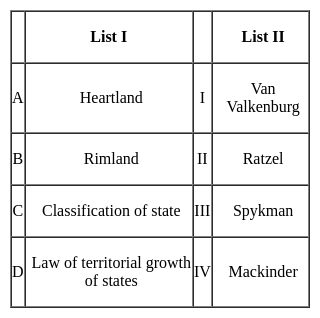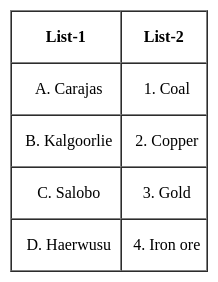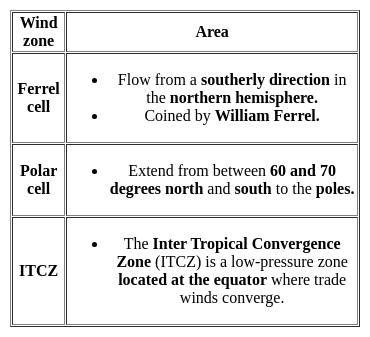MH SET Paper 2 Mock Test - 6 (Geography) - MAHA TET MCQ
30 Questions MCQ Test MH SET Mock Test Series 2025 - MH SET Paper 2 Mock Test - 6 (Geography)
Given below are two statements. One is labelled as Assertion (A) and the other is labelled as Reason (R).The Egyptians used to call Assertion (A): The density of oceanic water depends upon temperature and salinity.
Reason (R) : The density of water increases as the temperature increases.
Select the correct answer from options given below:
Which of these is not a type of federal state ?
The concept largely developed by the Berkeley School of Thought, led by Carl o Sauer about the humanized geographical content of the region/ space is
i. The type of society has strong influence over the environment .
ii. Human characteristics have impact on the environment.
iii. Education is a key factor on people’s view of life.
iv. Ecosystem services are important for human well-being.
Choose the correct option from below:
Match List I with List II:

Choose the correct answer from the options given below:
____________ predominantly acts as the agent of chemical erosion of soil.
Which of the following statements is correct?
(1) The Oceanic crust is thinner as compared to the continental crust.
(2) Topmost layer of the Mantle is known as the Asthenosphere.
(3) The density of the outer core is higher than that of the inner core.
(4) The core is made up of heavy materials like Iron and Nickel.
Given below are two statements, one is labelled as Assertion (A) and the other is labelled as Reason (R). Read the statements and choose the correct answer using the code given below.
Assertion (A) :
Reason (R) : Prices and demand of real increases as distance towards CBD reduces.
a) The Geographical Pivot of History was written by Sir Halford Mackinder in the year 1904
b) According to Spykman, aerial mobility is the new type of geopolitical structure.
Which of the following options are correct?
Which of the following options is Incorrect?
After which period the political geography came into limelight?
(a) The satellite towns are a part of the main city’s municipal corporation.
(b) The satellite towns develop beyond city’s green belt.
(c) The satellite towns are totally dependent upon the main city area.
(d) The satellite towns are separated from the main city physically by a geographical barrier like river.
Code:
i. Paris Agreement is known to combat climate change.
ii. Agreement aimed at global green house gas emission reduction.
iii. The conference held in 2015
Choose the correct option from below:
a) To optimise agricultural production
b) To increase farm income
c) To generate more employment
Choose the correct option:
Consider the following statements:-
a) Davis along with erosional processes also stressed on biological processes as a contributing factor.
b) Davis’ cycle of erosion is the most widely accepted theory and is also applicable in numerous approaches of landform development.
c) According to Penck, development of landscape is not time dependent.
d) The Youthful stage of Davisian cycle of erosion is characterized by vertical erosion and valley deepening.
Which of the following statement is correct?
Match the following mining regions for which it is famous for :

Select the correct code :
Which of the following maps are drawn to register the ownership of landed property by demarcating the boundaries of fields and building etc.?
|
60 tests
|






















